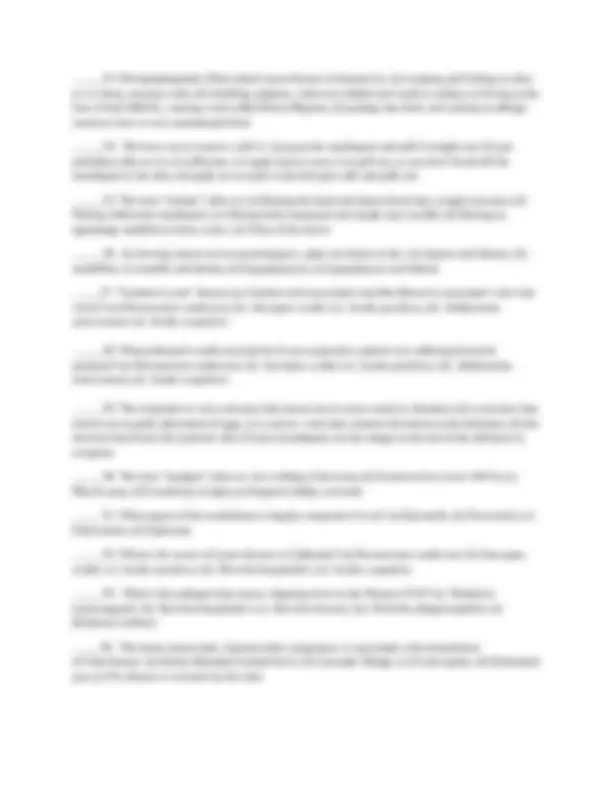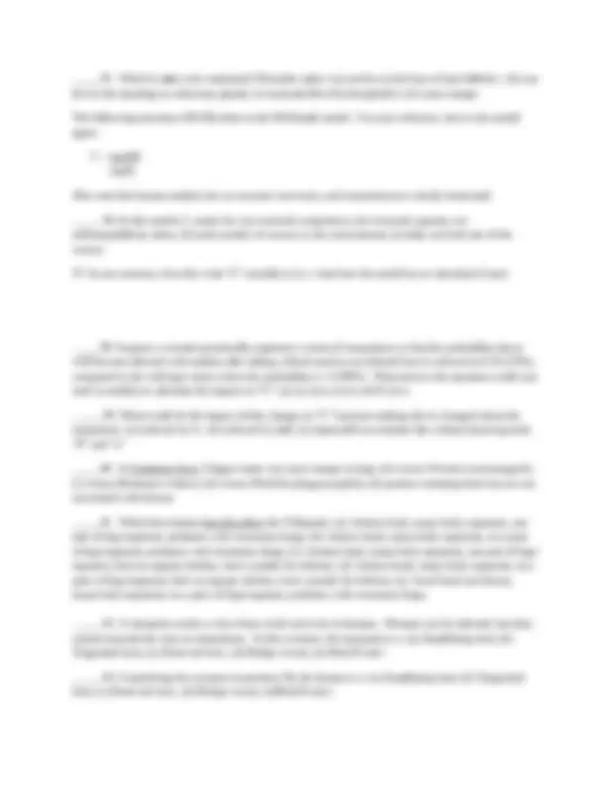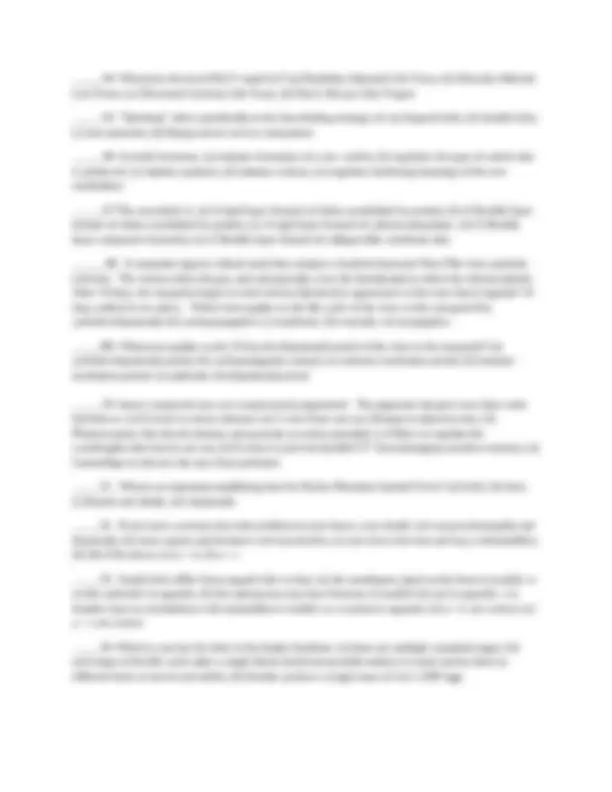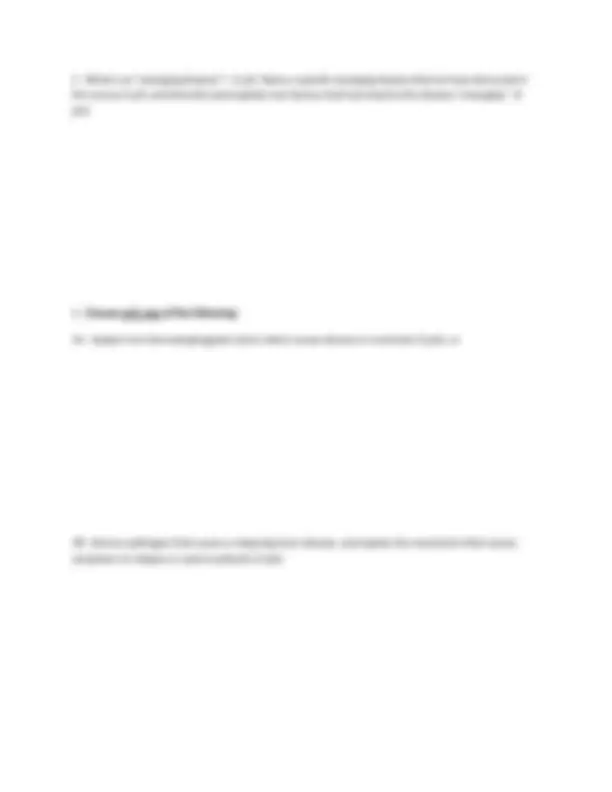







Study with the several resources on Docsity

Earn points by helping other students or get them with a premium plan


Prepare for your exams
Study with the several resources on Docsity

Earn points to download
Earn points by helping other students or get them with a premium plan
Community
Ask the community for help and clear up your study doubts
Discover the best universities in your country according to Docsity users
Free resources
Download our free guides on studying techniques, anxiety management strategies, and thesis advice from Docsity tutors
Material Type: Exam; Professor: Champagne; Class: Medical Entomology Lecture; Subject: Entomology; University: University of Georgia; Term: Spring 2012;
Typology: Exams
1 / 9

This page cannot be seen from the preview
Don't miss anything!







On special offer
Medical Entomology ENTO 3645/ Midterm Test 1 September 13, 2012 Name: __________________________ MyID: _____________________ What course are you in? (Circle one) 3645 3650 Multiple choice/fill in the blank. Each multiple choice question is worth 1 ½ points. Matching questions are wroth 1 pt each. _____1. The term “vertical transmission” applies to a situation where: (a) a pathogen is transmitted from mother to offspring; (b) a pathogen is transmitted from one host that is at a lower trophic level to one at a higher trophic level; (c) a pathogen is transmitted from one host to another by contact; (d) a pathogen is transmitted as a result of contamination of the surface of the vector _____2. What name applies to the highest taxonomic group that fits the description “arthropods with mandibulate mouthparts and one pair of antennae”? (a) Atelocerata, (b) Crustacea, (c) Arachnomorpha, (d) Pentastomatida, (e)Hexapoda _____3. The first scientific demonstration that arthropods play a role in transmission of some pathogens is attributed to: (a) Ross, who studied malaria; (b) Smith and Kilborne, who studied Texas cattle fever; (c) Manson, who studied lymphatic filariasis; (d) Chagas, who studied American trypanosomiasis _____4. What two groups of arthropods have chelate appendages: (a) Hexapoda and Acari, (b) Crustacea and Scorpiones, (c) Hexapoda and Scorpiones, (d) Acari and Crustacea, (e) Hexapoda and Crustacea _____5. What hormone initiates the series of events that culminate in molting: (a) Ecdysone, (b) PTTH, (c) Juvenile hormone, (d) Molting hormone, (e) Bursicon _____6. You are looking at an insect antenna through a scanning electron microscope you keep in your basement. You observe what appear to be hairs, but they aren’t flexible, and they have pores all over their surface. What function would you expect these hairs to have? (a) Defense, they protect the antennae against damage, (b) Mechanoreception, (c) Thermoreception, (d) Taste reception, (e) Olfaction _____7. A disease that can infect humans, but in which rodents are the primary reservoir, is called an: (a) epidemic, (b) enzootic, (c) anthroponosis, (d) emerging disease, (e) zoonosis _____8. Demodex mites can be found: (a) at the base of hair follicles, (b) glued to hair shafts, (c) in the openings to sebaceous glands, (d) a+b, (e) a+c, (f) b+c _____9. A patient, who is a native of Georgia and who has not travelled abroad, presents with symptoms that include myalgia and a pronounced petechial rash. A presumptive diagnosis would be: (a) Rocky Mountain Spotted Fever, (b) Lyme disease, (c) Rickettsial Pox, (d) Scrub Typhus, (e) none of the above _____10. A patient, who is a native of Georgia and who has not travelled abroad, presents with symptoms that include myalgia and a pronounced petechial rash. The patient reports experiencing a tick bite, but did not save the tick for identification. Nevertheless, you are confident that the tick was: (a) Ixodes
scapularis , (b) Amblyomma americanum , (c) Rhipicephalus sanguineus , (d) Ornithodoros hermsii , (e) Dermacentor variabilis _____11. Sarcoptes mites: (a) form a burrow into the skin, and feed on blood from capillaries, (b) hide in the base of hair follicles, and feed by piercing cells and sucking the contents, (c) form a burrow into the skin and feed on lymph fluid and inflammatory cells that respond to the irritation, (d) feed on shed flakes of skin and hair _____12. Monocytic ehrlichiosis is caused/vectored by which pathogen/vector: (a) Borrelia burgdorferi/Ixodes scapularis , (b) Borrelia burgdorferi/Amblyomma americanum , (c) Ehrlichia chaffeensis/Ixodes scapularis , (d) Ehrlichia chaffeensis/Amblyomma americanum , (e) Anaplasma phagocytophyllum/Ixodes scapularis _____13. A vertebrate host that can be infected with a pathogen, but which does not support transmission to vectors, is called a: (a) tangential host, (b) reservoir host, (c) dead end host, (d) two of these are correct, (e) all three of these are correct _____14. Insect saliva contains an enzyme called apyrase. This enzyme: (a) breaks down ADP, (b) inhibits clotting, (c) causes vasodilation, (d) blocks platelets from aggregating, (e) a+b, (f) a+d _____15. A structure that insects use to guide placement of eggs is the: (a) Cercus, (b) Spiracle, (c) Tarsomere,(d) Seta, (e) Ovipositor _____16. The Malpighian tubules have what function? (a) They carry out excretion of metabolic wastes, (b) They are involved in respiration, (c) They help in circulation of the blood, (d) They are a component of the reproductive system, (e) They secrete hormones that regulate homeostasis _____ 17. In arthropods, air enters the body through: (a) the mouth; (b) spiracles; (c) cerci; (d) the antennae; (e) the ovipositor _____18. What group of arthropods are characterized by having no antennae, four pairs of legs in the adult, and the head/thorax/abdomen fused into one unit without obvious segmentation: (a) Atelocerata; (b) Crustacea; (c) Acari; (d) Scorpiones; (d) Diplopoda _____ 19. The interval of time between when a vector takes an infectious meal, and when it begins to transmit the pathogen, is referred to as the: (a) vectorial capacity; (b) intrinsic incubation period; (c) vectorial competence; (d) extrinsic incubation period. _____ 20. Insects that feed exclusively on a nutritionally restricted diet, such as blood, rely on what mechanism to compensate? (a) bacterial symbiotes; (b) a crop between the esophagous and the midgut; (c) slow growth/long life cycles; (d) ability to rapidly produce a high level of digestive enzymes. _____ 21.Which is not a characteristic of the Order Aranea? (a) Cephalothorax and opistosoma joined by a narrow pedicel; (b) Mandibulate mouthparts; (c) Pedipalps small and with sensory function; (d) Four pairs of legs (e) Chelicerae modified as fangs _____ 22. Insect compound eyes are composed of a large array of individual light-sensing organs. Each component light-sensing organ is called : (a) a spiracle; (b) a cercus; (c) a trochanter; (d) an ocellus
_____35. Which is not a true statement? Demodex mites: (a) can live at the base of hair follicles ; (b) can live in the openings to sebaceous glands; (c) transmit Borrelia burgdorferi ; (d) cause mange The following questions (36-39) relate to the McDonald model. For your reference, here is the model again: C ~ ma^2 bPn -ln(P) Also note that human malaria has no zoonotic reservoirs, and transmission is strictly horizontal. _____ 36. In this model, C stands for: (a) vectorial competence; (b) vectorial capacity; (c) anthropophilicity index; (d) total number of vectors in the environment; (e) daily survival rate of the vectors
_____ 44. What does the term DALY stand for? (a) Disability Adjusted Life Years; (b) Directly Affected Lost Years; (c) Decreased Activity Life Years; (d) Don’t Always Like Yogurt _____ 45. “Questing” refers specifically to the host-finding strategy of: (a) Argasid ticks; (b) Ixodid ticks; (c) nest parasites; (d) flying insects such as mosquitoes _____ 46. Juvenile hormone: (a) initiates formation of a new cuticle; (b) regulates the type of cuticle that is produced; (c) initiates apolysis; (d) initiates ecdysis; (e) regulates hardening (tanning) of the new exoskekton _____ 47.The exocuticle is: (a) A rigid layer formed of chitin crosslinked by protein; (b) A flexible layer formed of chitin crosslinked by protein; (c) A rigid layer formed of calcium phosphate ; (d) A flexible layer composed of protein; (e) A flexible layer formed of collagen like vertebrate skin ______48. A mosquito ingests a blood meal that contains a hundred thousand West Nile virus particles (virions). The virions infect the gut, and subsequently cross the hemolymph to infect the salivary glands. After 10 days, the mosquito begins to shed virions (identical in appearance to the ones that it ingested 10 days earlier) in its saliva. Which term applies to the life cycle of the virus in this mosquito?(a) cyclodevelopmental; (b) cyclopropagative; (c) epidemic; (d) enzootic; (e) propagative _____49) What term applies to the 10 day developmental period of the virus in the mosquito? (a) cyclodevelopmental period; (b) cyclopropagative period; (c) extrinsic incubation period; (d) intrinsic incubation period; (e) epidemic developmental period _____ 50. Insect compound eyes are conspicuously pigmented. The pigments that give eyes their color function as: (a) Screens to ensure photons can’t cross from one eye element to adjacent ones; (b) Photoreceptors that absorb photons and generate an action potential; (c) Filters to regulate the wavelengths that insects can see; (d) Screens to prevent harmful UV from damaging sensitive neurons; (e) Camouflage to obscure the eyes from predators _____51. What is an important amplifying host for Rocky Mountain Spotted Fever? (a) birds; (b) deer; (c) lizards and skinks; (d) chipmunks _____52. If you have a serious dust mite problem in your house, you should: (a) vacuum thoroughly and frequently; (b) treat carpets and furniture with insecticides; (c) turn down the heat and buy a dehumidifier; (d) all of the above; (e) a + b; (f) a + c _____53. Ixodid ticks differ from argasid ticks in that: (a) the mouthparts attach at the front in ixodids vs on the underside in argasids; (b) the opistosoma may have festoons in ixodids but not in argasids; (c) females have an exoskeleton with mammillae in ixodids vs a scutum in argasids; (d) a + b are correct; (e) a + c are correct _____54. Which is not true for ticks in the family Ixodidae: (a) there are multiple nymphal stages; (b) each stage of the life cycle takes a single blood meal (except adult males); (c) most species feed on different hosts as larvae and adults; (d) females produce a single mass of over 1,000 eggs
Name: ___________________ ______ MyID: ________________________ Which course are you in? (Circle one): 3645 3650 Written Answer Part Most of these questions can be answered in a sentence or two, but a few will require a paragraph or two. Point form answers are also acceptable. The space on the page should be sufficient, but if necessary you can also use the back of the page. 20 points total.